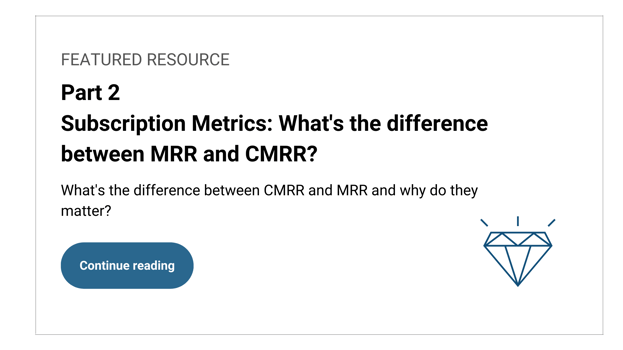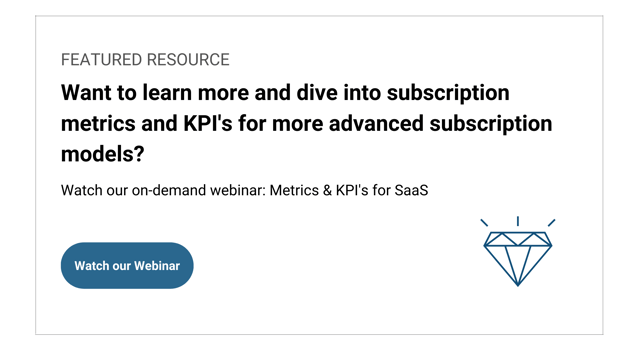Subscription Metrics Part 1: Recurring Revenue in B2B
Blog about recurring revenue metrics for SaaS B2B companies, clarifying the essentials of subscription metrics with a simple subscription example.

Intro
Subscription metrics can be puzzling and sometimes turn into an entangled mess. This is a blog series to clarify the essentials of subscription metrics, and hash out the complexities, starting with a simple introduction going through the main KPIs, to then dive deeper into more advanced scenarios. In this introductory article, we have a simple subscription example to guide you through the most important KPIs, how they work, why they matter, and how they are different from each other.
Our example is a subscription with a 100 EUR monthly price, running 3 months from January 1st, 2021, billed quarterly in advance and with a revenue recognition monthly over time. See specifics below:

The subscription was signed by the customer, Bob’s Company, on November 15th.
Business Events and KPIs
Without the fact of invoices being sent and cash coming into our bank account for the subscription, we want to make forecasts and see metrics on what this subscription means for our business, to be able to measure performance and predict our revenue and cash.
Bookings
A subscription lifecycle with a customer starts with a booking, which we define as a business event, generating metrics from what is contracted with the customer on a specific date.
Bookings and the metrics they generate are often used to measure business performance and forecasting future developments.
- Side example: in the last quarter we added 1500 EUR in recurring revenue from new customers, 500 EUR in expansion from existing customers, and lost 500 EUR worth of customer contracts, leaving us with a net increase of 1500 EUR CMRR for the quarter.
In our example, we will generate a booking on November 15th when the order is activated:

Contracted Monthly Recurring Revenue
This booking will generate some metrics, one being the CMRR, used to measure the monthly recurring revenue that we have contracted and will remain throughout time, assuming all subscriptions will be renewed, nothing canceled, and no changes are made.
In this example, the CMRR will start with 100 EUR in November as the subscription was signed and activated during that month, and will then be 100 EUR continuously over time until a change to the contract is made that affects the CMRR.
Monthly Recurring Revenue
We use MRR to measure the revenue every month according to the monthly price and the effective start & end dates of the subscription period (the actual revenue per month according to the monthly price). This is a useful KPI to measure and forecast our future revenue on a monthly basis.
- Side note: for some companies, ARR (Annual Recurring Revenue) is a better metric, if all or a majority of customer contracts are billed annually, and maybe also signed for a 12-month period. The ins and outs of ARR will be covered in an article later in the blog series.
In this case, the committed MRR will be 100 EUR until the subscription ends after March. However, we will have a 100 EUR MRR from April as well, categorized as automatic renewal, meaning that the 100 EUR MRR will continue if the subscription is automatically renewed.

Financial Events and Revenue
Now we will send an invoice for this subscription. Other than creating accounting transactions and hopefully generating real cash in our bank account, we need to recognize the revenue properly.
Invoice
The invoice is actually posted and sent to the customer on December 1st for the 300 EUR over the quarterly billing period.

Revenue Recognition
When the invoice for the first billing period of the subscription (Jan-March 2021) is posted, a revenue recognition schedule is generated – and as the revenue recognition rule for this subscription is monthly over time, the revenue schedule will look like this:

Summary
So, as we can see, business events and financial events generate some interesting SaaS KPIs. When in December, this is what we will know and what the aforementioned KPIs will look like, summarized:

Fast forward a couple of months and, hopefully, the subscription is renewed for X months, the Auto-Renewal MRR turns into Committed MRR, another invoice is sent, and more revenue is recognized.
It is important to see the difference between KPIs such as CMRR and MRR, understanding what KPIs are generated from the booking, the subscription, and from an actual invoice as a financial event:

Understanding these metrics and the distinctions between them is a powerful and extremely useful way of understanding the performance of your business, improving decision-making, and forecasting the future.
Stay tuned for more blogs about subscription metrics in which we will dive deeper into more complex subscriptions with multiple charges, mixed charge types, different charge & billing periods, ramp-ups, order changes (upsells, downsells, renewals, price adjustments), usage, custom revenue recognition rules, etc., and how it will affect our subscription metrics.
Until then, download our Pricing & Monetization Guidebook to learn more about value-based monetization of your subscription business, or request a demo to learn more about Younium as a B2B subscription hub.

